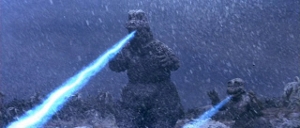
You’ll have to get over a few hurtles to enjoy Son of Godzilla, the first being its title. Japanese audiences knew this as Kaiju-shima no Kessen Gojira no Musuko. Obviously its American distributor changed the title to force a parallel with King Kong’s 1933 shameless cash-in sequel (which I like sooo much I rarely even speak its name). Nowadays, after decades of watching this film on television, there’s no way John Q. Public would ever pick up a copy of Monster Island’s Decisive Battle: Godzilla’s Son. What the fuck is that, when you can just call it “Son of Godzilla?” So Son of Godzilla it will forever be, with all the baggage that implies.
I’ve been alive long enough to see the stock of all twenty-nine Godzilla movies rise, fall and rise again…except Son of Godzilla. The fan view of this film remains as firmly divided as the two sides of the Grand Canyon. Half the fanbase loves it and consider it a childhood classic they would gladly pass down to their own children. As I type this, my skin’s aching to peel itself off and crawl away from the computer in terror…but Son of Godzilla really is one of the first “family friendly” monster movies in daikaiju history. There’s some…iffy stuff here, sure…but nothing too hard for the little rugrats (or, more importantly, their skittish parents). No longer an avatar of nuclear horror, Godzilla’s story here is the story of a reluctant foster parent, trying to be the dad he never had. It’s Toho’s Disney movie, and its fans argue that makes perfect mulch for any budding G-fan. They’d recommend it to everyone, kids from one to ninety-two, with no reservation whatsoever.
I’m not one of those people.
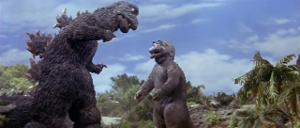
The other half of the fanbase hates “family friendly” anything, because we’re all secretly (and not so secretly) misanthropic bastards. We watch monster movies to see cities set afire and the military-industrial complexes of Great Nations laid waste. I’d argue your entire family would benefit from seeing that early and often. It’s certainly done wonders for me.
Sure, we need Accidental Parent stories, but who else is arguing for stories of fiery carnage? Like the Biblical conflagration that ends Godzilla: 1985. Or the trip through packed field hospitals in the original Godzilla, backed by a haunting children’s choir. I can’t watch Son of Godzilla without flashing back to those images, which ground the whole daikaiju genre in a very horrible place. No matter how commercial it gets or how far afield it wanders, this genre exists as a monument. A marker, placed so that we’ll never forget what could happen…and what’s already happened.
So here’s the poop on Son of Godzilla. Since Ishiro Honda had to go make King Kong Escapes, Jun Fukuda, who proved he could handle the organized chaos involved in making a Godzilla movie with the previous year’s Godzilla vs. the Sea Monster, once again won the big chair. Like vs. The Sea Monster, Toho sold this movie off quick and cheaply to an American television distribution company named the Walter Reade Organization. They provide the second thing you’ll have to get over if you want to enjoy this film: it’s atrocious original dubbing by our “good friends” at Titra Studios…dubbers of, among other things, the original Speed Racer cartoon.
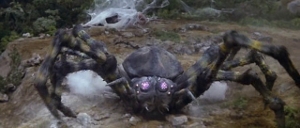
Oh yeah: it’s that bad. And now that I can watch Sony’s DVD, I lay a full twenty-five percent of my long-standing annoyance with this movie at the feet of Titra’s bad dubbing. That may not sound like much but every little bit helps in this business. (Which is why you should all email this website to twenty of your gabbiest friends. Don’t wait: do it now.) So, since I’m watching the original version of this film in its original language like a good snob, those problems are moot and I’ve eliminated film’s two major excuses. This is it, Son of Godzilla: it’s go-time. Should you leave my island you will be an instrument of Death, praying for war.
This film’s fans (including the one that hosts this website) praise it for breaking with what had become the Godzilla series formula: monster shows up, Godzilla shows up, big fight, the end. I still see where they’re coming from, even though all those things still happen. They’re just embedded in a glossy block of classic Jungle Adventure tropes, garnished with mid-century Super Science.
All of which I dearly love. But even with all that, we still end up following the familiar stock character triad of Scientist, Reporter and Chick. Maroon it on a deserted island and the Godzilla franchise will still cling to its Stock Character Tarot Deck. Hell, in terms of character creation, Godzilla vs. the Sea Monster is more of a wild departure than this. If anything, for his sixth Godzilla movie in a row, screenwriter Shinichi Sekizawa went back to The Formula. Wouldn’t do to follow characters who aren’t bland. If they were otherwise, they might not be so internationally “relatable.”
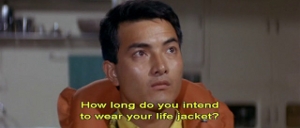
Structurally, Son of Godzilla reminds me of an American mid-50s monster film – one of the many, many rip-offs of The Thing from Another World. Maybe it’s the location: a UN scientific outpost full of Manly Men on the deserted, south sea island of Sollgell. Maybe it’s the sausage fest of an initial cast, most of whom the film ignores. Our Reporter – who parachutes into the movie from an overflying cargo plane in a move that would make Batman proud – is just too damn cool to give the rest of these suckers any face-time…unless and until they go crazy.
This is Goro Maki (Akira Kubo), the first Reporter in the series with a self-proclaimed super power: his nose for news. “The smell of a story” led him to Sollgell Island, and he’ll be damned if he leaves before he finds out what’s going on around here. Unwilling to kill him themselves, the scientists agree and draft Goro as their new chief cook and bottle-washer. So much for that conflict. Goro’s integrated into the team within the space of a montage. Only the surly Furukawa (Yoshio Tsuchiya) holds onto his antipathy…and everybody in camp understands Furukawa’s getting sick of the cast away’s life.
This motley bunch’s engaged in some ol’ fashioned weather control experiments. Specifically, a weird species of cloud seeding that, like Godzilla himself, uses nuclear explosions as a power source. This patently-insane idea’s accepted as casually as the head scientist, Professor Kusumi’s (Tadao Takashima, in his second Godzilla movie), pronouncement that “World population is reaching its limit…The African deserts, Siberian tundras, the South American jungles: they’re useless to us now.” Along with everyone still dumb enough to live there…right, Doc?
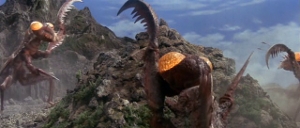
The initial test goes well…until mysterious radio interference royally screws with Our Heroes timing. Their bomb detonates too early, drenching Sollgell in a radioactive deluge. All our humans make it through with lymph nodes intact and tongues miraculously un-swelled. Sollgell’s population of giant insects come out even further ahead, swelling to cruise-ship size thanks to all the ambient radioactivity…that dissipates at warp speed and is never mentioned again. Sure hope these guys have all the kids they want back home. From this day forth, the survivors of Sollgell will be shooting more blanks than an action movie stunt crew.
Seemingly realizing this, Furukawa goes mad – mad, I tell you, mad, mwuahhahahaha – with homesickness and tears-ass through the remains of their camp with a gun. With the whole team ducking, Furukawa charges the beach, swearing to the Professor’s Number 2, Fujisaki (Akihiko Hirata, in his fifth role as a Scientist in as many Godzilla movies) that he’ll swim home if that’s what it takes. Foolish mortal. Little does he realize his world is ruled by a mad god named Jun Fukuda. Who proceeds to drop Godzilla on this poor, crazy, working stiff.
Lured by the radio interference (which everyone just figures for a psychic baby’s cry Godzilla picked up on…somehow), Godzilla trudges through the camp. The interference leads him to an egg the giant mantises have dug up. The egg hatches…bringing forth the most horrifying special effect ever conceived by the hand of man: a bouncing baby Godzilla that everyone will eventually call “Minya”…for whatever reason.

Minya (played by a rod puppet in his opening scene and by niche-famous, travel-sized Japanese actor “Little Man” Machan once he gains some height) is the last and largest hurtle between you and un-ironic enjoyment of this silly little monster movie. Whenever you hear fans of long-running series talk about certain reoccurring characters you’ll occasionally hear somebody, “You either love ’em or hate ’em. There’s no in-between.” I used to think that was true of Minya, so I was surprised as anyone to discover I don’t really hate the Minya we’re presented with here. As with so much else in Godzilla’s original series of films, Minya started off with promise that Toho squandered quickly and crassly.
Sure, between his glassy, too-wide, Muppet eyes and rotund, Stay Puft Marshmellow Man belly, Minya’s one ugly little fucker. Worse yet, Tsuburaya Studios designed a Godzilla suit just as ugly, attempt to sell the idea that Minya and Godzilla are members of the same species. The last suit, from vs. The Sea Monster, makes a brief appearance for Godzilla’s brief water scenes, but once the Big G strikes land, his entire morphology changes. His eyes get bigger and move to the top of his head, which becomes blocker than it’s ever been before, even in the old hand-puppet days of the mid-50s.
On the other hand, the addition of Minya and the story points that flow from him give Godzilla something to do now that he’s no longer wading through Japan’s major cities. Let’s be honest – up to this point, Godzilla wasn’t a character: he was a special effect who, in eight films, exchanged exactly one scene of dialogue with the other inhabitants in his universe…and that had to be translated for us by Mothra’s twin priestess.
Here, the absence of Mothra combines with some wonderful suit acting from Machen and the two actors who portray Godzilla on land (Yu “Ebirah/MechaniKong” Sekida and Seiji Onaka) to produce one of the most underrated pantomime routines in history. Once willing suspension of disbelief kicks in and you stop making fun of the costumes, believing in these monsters becomes absurdly easy.
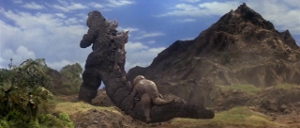
Part of that’s due to excellent sound design, which has the tough job of communicating Godzilla and Minya’s emotional range to a human audience that may not give two shits otherwise. (And might even be horrifically put-off by the idea of monsters having emotional range in the first place.) As horrific as rod puppet-Minya might be, and even with all the times I’ve watched this film, Minya’s birth scene (where Godzilla saves him from being eaten by a three-mantis tag team) is still harrowing because of the squealing sounds of pain and confusion put into Minya’s far-too-immobile mouth. This holds true up ’til and including my favorite scene, which I hope to reference without spoiling by calling it “that scene in the snow.” G-fans know what I’m talking about and the rest of you should find out. It may be the key scene that finally, after thirteen years and eight films, moved Godzilla from the role of Avatar of Nuclear Annihilation to Reluctant Adoptive Father and Defender of The “Natural” Order of Things. Godzilla, too, gets a major upgrade in his vocabulary, befitting the fact that, for the first time in the series, he’s interacting with another monster in a way that doesn’t involve active violence…only the passive violence that every human culture sanctions in the name of raising children.
Godzilla’s parenting regimen is a universally familiar because someone on this movie still felt the need to make a socially relevant point, even out here in the south pacific. Goro has a line in the original version that spells this out for denser members of the audience. Observing the films one-and-only really famous scene (Godzilla’s fatherly advise to Minya on how to roar like a champion and breath radioactive fire without someone stepping on your tail) Our Reporter comments, “Just like the education fanatics back home…they don’t let their children play.”
By the late-60s, Japanese education professionals were well on their way to cementing the their school system’s international reputation for steep competition, forced hierarchies and mind-shattering entrance exams. All in the name of creating a nation of hard workers specialized in technical marvels that rest of the world can’t do without. They saw themselves as we’re meant to see Godzilla here: tough but firm guardians of naive new life, doing what they have to to prepare the next generation for a harsh, uncaring world filled with dangerous creatures.
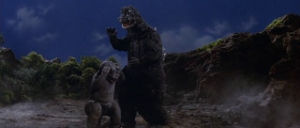
Humanizing Godzilla this much is also way easier than conceiving parental habits for giant radioactive lizards from scratch. This isn’t science fiction – Ishiro Honda took all the series’ remaining pretensions to SF with him – this is Adventure Fantasy at its most idyllic. Symbolized by the movie’s Chick, Saeko (or “Reiko” if you’re watching the English dub) Matsumiya (Bibari “Beverly” Maeda), the only daughter of legendary (in-universe) archeologist Dr. Matsumiya, who chose to remain on Sollgell after the Imperial Army abandoned it during World War II’s waning days.
Having grown up there with only her father and the native fauna for company, Saeko spends the first half of the movie playing a skittish cat-and-mouse game with Goro, who in his capacity as camp cook gets the shit-duty of foraging. The two eventually bond over a Hawaiian shirt Saeko stole off the camp clothes line, which Goro basically gifts to her after she proclaims it (in so many words) too girly. This is the beginning and end of her character arc, which isn’t an arc so much as a point – the kind of hypothetical point with no length and no width that only exists in the minds of math teachers. After this she’s as passive as any native guide in any given Tarzan film…though Beverly looks much better in a pair of khaki pants than any previous Jane.
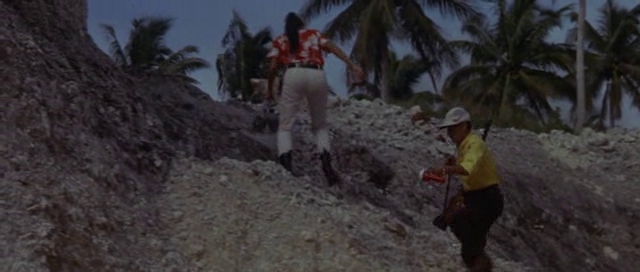
Oh…I’m sorry. Am I ruining this family friendly Godzilla film with my dirty mind? Well, I hope so, because that’s about all I could do to keep myself awake during Goro and Saeko’s Bogus Journey around Monster Island. Goro even calls it that at one point (though his line’s altered to omit the phrase from the English dub), meaning this is the film that provided 57% of modern daikaiju fan websites with their name, or some derivation thereof. I’m forced to grant it Plus One for Historical Importance.
But goddamn is its human cast ever supurfluious…moreso once Godzilla and Minya start interacting. That‘s the interesting story. Who cares about these science jerks? All they’ve ever done is fuck up the local weather. It’s all they can do, as revealed by the fact their weather control experiment serves as a Third Act trump card. Freeze the fucking monsters! Or drown ’em in radioactive flashfloods! Flush them back out to sea! It’s an incredibly obvious idea that Our Heroes take an hour and a half to think up.
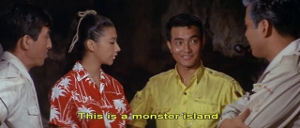
So the movie kills a lot of time while everyone waits around for Akihiko Hirata to repair the radio. Oh sure, Goro and Saeko have adventures…the Professor even sends them on an ol’ fashioned Fetch Quest to find a Native Cure to a Mysterious Tropical Disease the men contract two-thirds of the way through. Our leads find it, observe Godzilla instructed his new son, Goro makes that crack about education reformers back home, and they make it back to camp safely. The men are cured and the whole episode has zero lasting effect…apart from giving Furukawa another chance to wig out with a gun.
Furukawa stands out as the only character proactively working towards fulfilling his goals, making him my favorite of all the Science Jerks. Sure, Number 2’s fixing the squawk box, but there’s no passion in Hirata’s character. Everyone but Furukawa’s such a dry, one-dimensional Member of the Team they all bleed into each other. I couldn’t tell you anybody’s name. (Hell, I had to look up Number 2’s…I just called him “Serizawa” the whole time.) Nor do I care to. None of them do anything. Even the characters who do venture forth escape the film without a scratch. The Professor gets nicked by one of Furukawa’s errant shots, but that’s the only blood we see in a film with giant spiders, fire-breathing dinosaurs and loving shots of giant mantis mandibles cracking in anticipation of a morning meal. What’s the point of packing your cast with Red Shirts if you’re not going to kill them off?
What’s the point of placing characters in jeopardy we know they’re going to escape from, because this film doesn’t have the balls to kill them? If it were lulling us into a false sense of security with its human story (the way Godzilla and Minya’s arc lulls us into a false sense of lighthearted comedy before – BANG – giant spiders and that scene in the snow) that would be fine. Somebody could sacrifice themselves to allow the rest of the group to evacuate…like Dr. Serezawa did, way back in the original Godzilla. And…hey, there’s Akihiko Hirata right over there. Hey, man! What are you waiting for, another Oxygen Destroyer?
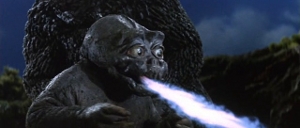
In the end I still have serious reservations about this film, just not for the reasons everyone usually ticks off. If you can get past the shitty Godzilla and Minya designs, this has some of the best monster action in the Godzilla series. I’d be a dick if I didn’t give due props to the army of puppeteers to brought all these giant insects, and one giant arachnid, to life. I’ve heard it took anywhere from a ten to fifteen-man team to pull of the Climactic Battle between Godzilla and Kumongora, the spider (known as Spiga in the West). I’d rate it as one of the Big G’s Ten Best Fights if I wanted to have no life and do something time consuming, like a Top Ten list.
So while the monster stuff is awesome, it’s bogged down by a whole lot of Disney-esque Adventure antics with Our Reporter and his Chick. Still, it’s visually and aurally dynamic, competently shot, and strangely…in the end…kinda poignant. It certainly has one of the best endings in the franchise. Considering that, and its historical import as the first Godzilla movie to actually be about Godzilla in thirteen years, I have to call it required viewing. But just barely. It squeaks by on the skin of its egg-teeth. And as we move through the rest of Godzilla’s series I expect we’ll reach that conclusion more often than not.
![]()
![]()
![]()

I have a soft spot for this film from childhood viewing (and as a kid the giant mantises and spiders just rock too hard to hate) but I know that my wife does not share my love, having seen the movies only as an adult and having been introduced to them with the original film.
Also, I can’t agree with you on the Janes….the 1930s Jane…wow. Which is not to say that this one isn’t super cute.
I was surprised I liked the movie as much as I did. It’s the first movie in the series where I find the human story completely superfluous, but the monster action pulls things out of the fire. About halfway through I realized the root of my hatred of Minya lies a bit down the road, in Godzilla’s Revenge.
I’ve always loved this one. My neighbor (six years my younger) used to borrow my Video Treasures VHS from me on a regular basis until we tracked down a copy of it at The Warehouse and gave it to him as a B-day present. I haven’t seen the Japanese language version of it, but I liked the dub fine…and Beverly Maeda is just a cutie.
Thank you, Blake! I fucking loved that Video Treasures editions of all these “island” films, and I’m glad someone finally brought them up again. I would’ve never seen this, Rodan, King Kong vs. Godzilla, Godzilla vs. The Sea Monster, or Godzilla’s Revenge without them, or the Wal-Mart bargain bin I found them all in around the early 90s. I’d urge any VHS enthusiasts to track them down, if for no other reason than to hear their classic dub track, which is currently unavailable on DVD.
Titra’s dubbing is not the dub track heard on Sony’s DVD. That is the dubbing done for the international version of the movie Toho created to sell the movie overseas. Titra’s dubbing has not been heard [officially] since the movie was on VHS.